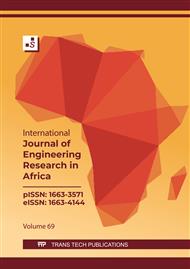[1]
R. Sindhwani, P.L. Singh, A. Behl, S. Afridi Mohd, D. Sammanit, A.K. Tiwari, Modeling the critical success factors of implementing net zero emission (NZE) and promoting resilience and social value creation. Technol. Forecast. Soc. Change., 181 (2022) 121759.
DOI: 10.1016/j.techfore.2022.121759
Google Scholar
[2]
A. O. M. Maka, J. M. Alabid, Solar energy technology and its roles in sustainable development. Clean Energy, 6 (2022) 476–483.
DOI: 10.1093/ce/zkac023
Google Scholar
[3]
A. Maftouh, O. El Fatni, S. Bouzekri, F. Rajabi, M. Sillanpää, M.H. Butt, Economic feasibility of solar-powered reverse osmosis water desalination: a comparative systemic review. Environ. Sci. Pollut. Res., 30 (2023) 2341-2354.
DOI: 10.1007/s11356-022-24116-z
Google Scholar
[4]
M. Taoufik, M. Laghlimi, A. Fekri, Land suitability analysis for solar farms exploitation using the gis and analytic hierarchy process (AHP) – a case study of Morocco. Polityka Energetyczna, 24 (2021) 79–96.
DOI: 10.33223/epj/133474
Google Scholar
[5]
K. Adeli, M. Nachtane, A. Faik, D. Saifaoui, A. Boulezhar, How Green Hydrogen and Ammonia Are Revolutionizing the Future of Energy Production: A Comprehensive Review of the Latest Developments and Future Prospects. Appl. Sci., 13 (2023) 8711.
DOI: 10.3390/app13158711
Google Scholar
[6]
S. Oubenmoh, A. Allouhi, E.H. Sebbar, R. Saadani, A. Jamil, A. Ait Mssad, M. Rahmoune, M. Bentaleb, Energy assessment and economic study of solar floor heating system in different climates in Morocco. J. Sol. Energy Eng., 145 (2022) 011005.
DOI: 10.1115/1.4054709
Google Scholar
[7]
A. Maftouh, O. El Fatni, A. Echchikhi, T. Bahaj, K. Gueraoui, H. El Rhaleb, Effect of Feed Water Temperature on Reverse Osmosis Performance in a Borehole Water Desalination Plant: Numerical and Experimental Validation. Int. J. Eng. Appl. (IREA), 10 (2022) 252-264.
DOI: 10.15866/irea.v10i4.21290
Google Scholar
[8]
N.T. Al-Ashwal, A.S. Hassan, The integration of daylighting with artificial lighting to enhance building energy performance. AIP Conf. Proc., 1892 (2017) 160010.
DOI: 10.1063/1.5005777
Google Scholar
[9]
M.R. Nugraha, A. Adriansyah, Development of a solar radiation sensor system with pyranometer. Int. J. Electr. Comput. Eng., 12 (2022) 1385–1391.
Google Scholar
[10]
S.S. Priya, N.C. Freudenberg, A. Borkataky, Solar radiation measurement using raspberry pi and its modelling using artificial neural networks, in: MATEC Web of Conferences, EDP Sciences, 77 (2016) 06011.
DOI: 10.1051/matecconf/20167706011
Google Scholar
[11]
A. Maftouh, O. El Fatni, A. Echchikhi, H. El Rhaleb, Experimental and Mathematical Modelling of Reverse Osmosis System to Investigate the Impact of Feed Water Pressure: a Case Study, Int. Rev. Civ. Eng. (IRECE), 14 (2023) 42-55.
DOI: 10.15866/irece.v14i1.21621
Google Scholar
[12]
S.J. Oh, S. Dutton, S. Selkowitz, H.J. Han, Application of a coelostat daylighting system for energy savings and enhancement of indoor illumination: a case study under clear-sky conditions. Energy Build., 156 (2017) 173–186.
DOI: 10.1016/j.enbuild.2017.08.081
Google Scholar
[13]
A. Balabel, M. Alwetaishi, A. Abdelhafiz, U. Issa, I.A. Sharaky, A.K. Shamseldin, M. Al-Surf, M. Al-Harthi, Potential of solatube technology as passive daylight systems for sustainable buildings in Saudi Arabia. Alex. Eng. J., 61 (2022) 339–353.
DOI: 10.1016/j.aej.2021.06.001
Google Scholar
[14]
Y. El Mghouchi, A. El Bouardi, Z. Choulli, T. Ajzoul, Models for obtaining the daily direct, diffuse and global solar radiations. Renew. Sustain. Energy Rev., 56 (2016) 87–99.
DOI: 10.1016/j.rser.2015.11.044
Google Scholar
[15]
M. Xiao, Z. Yu, Y. Cui, Evaluation and estimation of daily global solar radiation from the estimated direct and diffuse solar radiation. Theor. Appl. Climatol., 140 (2020) 983–992.
DOI: 10.1007/s00704-020-03140-4
Google Scholar
[16]
A. Domínguez-Álvarez, M.T. de-Tena-Rey, L. García-Moruno, Modelling global solar radiation to optimise agricultural production. Span. J. Agric. Res., 19 (2021) e0201–e0201.
DOI: 10.5424/sjar/2021191-16813
Google Scholar
[17]
A.S. Jihad, M. Tahiri, Contribution to the study of two methods for estimating direct and diffuse solar radiation in Morocco at the Fès-Saïs site. Int. J. Civ. Eng. Technol., 10 (2019) 1664–1673.
Google Scholar
[18]
M. Benchrifa, H. Essalhi, R. Tadili, H. Nfaoui, Estimation of daily direct solar radiation for Rabat, in: Sayigh, A. (eds) Sustain. Energy Dev. Innov., Innov. Renew. Energy. Springer, Cham, 2022, p.629–634.
DOI: 10.1007/978-3-030-76221-6_69
Google Scholar
[19]
H. Sani Dan Nomao, M. Boukar, S. Madougou, Study of Four (4) Semi-empirical models for estimating direct radiation from the sun and modeling for application to the solar thermodynamic system. Eur. J. Appl. Sci., 10 (2022) 765–782.
DOI: 10.14738/aivp.104.12950
Google Scholar
[20]
M. Ghodbane, B. Boumeddane, Estimating solar radiation according to semi-empirical approach of Perrin de Brichambaut: application on several areas with different climate in Algeria. Sahara, 4 (2016) 20–29.
DOI: 10.47238/ijeca.v1i1.12
Google Scholar
[21]
Z. Kouis, Photovoltaic power potential in Cyprus and how the synergies observed in an Agrivoltaic system affect the efficiency of food and energy production (Doctoral dissertation, Hochschule Rhein-Waal) (2022).
Google Scholar
[22]
M. Ayoub, A review on machine learning algorithms to predict daylighting inside buildings. Sol. Energy, 202 (2020) 249–275.
DOI: 10.1016/j.solener.2020.03.104
Google Scholar


